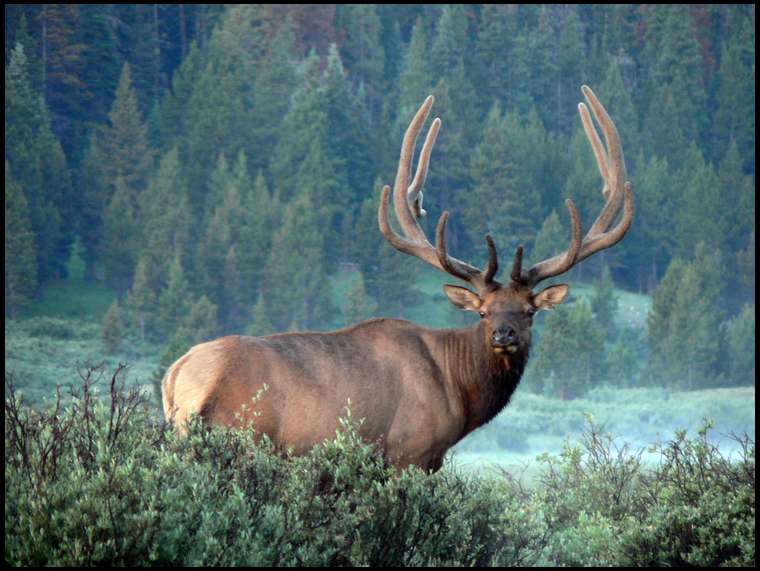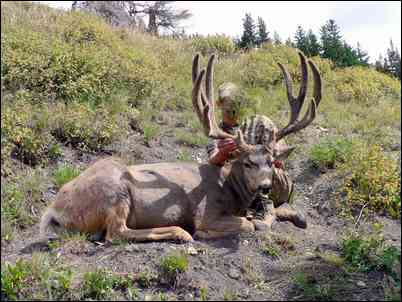Does a wet summer really make a diff?
Elk
Like the title states- does a wet summer really make a difference in elk antler growth or even location of the summer concentration areas?
Maybe the elk won’t need to go as high to get into good forage.
If good feed does effect antler growth, how much does it?
I can't answer your question but this guy is off to a good start.
I believe I heard a podcast with Steve from wards saying elk were down 30” during the drought year. Elk that had been on camera the previous year.
Not elk, but in AK a wet summer meant more mature cow moose had twins the NEXT summer.
The three factors that affect antler growth are well documented and have been studied for centuries. The factors that dictate year to year growth are the age of the animal, its genetic makeup, and its nutritional intake
I’d have to say the more feed, the more likely a bull will grow to it’s full potential. If there’s lots of good, quality feed, to me it only makes sense that the extra nutrition will be utilized for antler growth.
I believe this picture is a good example of what poor nutrition in a dry year can do. This is a rifle kill, but I think it's pertinent to this discussion. This is a nice bull, but look at the hunters left hand just below the third tine. The main beam is so massive he can't get his hand around it, but past the third, it gets much smaller. The first and seconds tines are also considerably heavier than the 3rd through 6ths. This bull was killed last year in Colorado's extreme drought and I think it's a good example of an animal that started off really well but ran out of nutrition. Curious if you guys agree with this assessment.
I totally agree with your assessment,and by the way I have an Az.archery bull tag.
I agree Brun. But, I think what gets lost is this isn’t a one year affect. Meaning the good forage will result in better horns next year as long as they don’t get stressed to bad. And live till then. As dry as thing we’re in CO last year, animals had to be depleted going into winter.
I think this matters more in AZ and NM than farther north. Farther north, the elk have almost unlimited summer range with the limits to their numbers coming from winter range, especially in the areas where there's lots of wilderness at high elevation. There's a ton of wilderness in elk range that never-rarely ever gets visited by an elk.
I believe Ike is correct....desert units are more likely to have antler growth affected but high country areas, even in drought years, there’s plenty of quality feed and water from April to August when antlers are growing.
Gee, more water, more nutrition for antler growth. What a concept!!
Sorry, but I'm feeling froggy, and some of these questions crack me up.
;-)
Matt
I hunted my favorite draw unit the first time on a real dry year and the elk were congregated above tree line during hunting season, two years later I hunted same unit and the elk seemed to be much more dispersed, don't really know about antler growth, seen some real hogs during the dry year. Also that's not a lot of time line to draw deductions from, third time I hunted it it was wetter than first time and it was similar to second time!
If a wet year promotes antler growth, why is Colorado notorious for weak thirds? Especially in the NW units?
Oh wait. That would be genetics. Haha
I have no doubt drought affects antler growth and where the elk won't be if it's dry. Conversely on a heavy snow year like CO is seeing this year, antler growth should be great. But will they move into their normal areas? Or have they moved to different areas because of late run off/snow melt?
Having good wintering range/grounds leading into a wet spring and early summer with a good green up lush-n-thick growth of habitat is equally important.
I've really noticed this year on some of my scouting trips here in the Rocky Mnt states and my daily hikes on the mountain trails around here, that the Muley bucks are really impressive going into July as well as the Bull Moose and Bull Elk.
For some reason, I think moisture effects the Antler Species more than the Horn Species.
Good luck, Robb
Robb,
I'm noticing the same around my place. Bucks and bulls are looking great. Not much difference with the antelope.
I've read that the horns on antelope are actually a body cooling mechanism, like a radiator on a car. That's why antelope horns generally grow larger in hotter climates.
Matt
I think the location question is a good one. The bucks and bulls of SD live in a generally arid environment. If we get wet years like we did last year and this year it opens up a lot more suitable range for them to inhabit. I certainly noticed this with our elk herd last fall and our mule deer to a lesser extent..
Don't want to be a downer but it seems like EHD spikes with wet springs, summers followed by hot and dry. Hope not.
From personal observation, I think so. I also think that when you have a very dry year it seems the antlers are more brittle. I’ve noticed during dry years I seem to see a lot more busted up racks.

YEP!

YEP!

YEP, yep

YEP, yep

YEP,YEP,YEEP

YEP,YEP,YEEP

YEP YEP YEP YEP!

YEP YEP YEP YEP!
Brun I shot a bull last fall in Co and it had the same traits as the one in your post. He was a small six frame but his bottoms had more mass than a 300 plus that I have on the wall here. He also ate like an older elk as in very flavorful and on the tough side. I will add that his body was not near as big as some I have killed in this area. He didn't appear skinny just small. My assumption is that as the food source dwindles antler growth slows.
What a difference a year makes.
A year ago, when we came home from our month-long vacation in Florida, my lawn was brown and didn't even need to be mowed. The pic above is what I came home to this year.
Matt
Here is a picture of the rack. Notice his right side up top is somewhat in proportional to his bases. I guess he is more of a 5 point lol my how horns and fish grow after they die.
Looks like the consensus is wet years promote antler growth....
So, do animals change their summer migration patterns with more/better food sources available in different areas?
320,
I think you and Brun are on to something. I've killed bulls and bucks during drought years that displayed the same characteristics....good bases and brows, then everything peters out towards the tops.
Matt
I definitely think moisture and feed contribute to antler growth. But genetics plays into things as well.
I’ve have also found that on wet years it can be harder to locate elk. As they are spread it and feeding in weird places that sometimes don’t have feed. Years where there is feed all over in timber pockets and places the elk can literally be everywhere. Where as On dry years they can be more concentrated and feeding In parks and normal elk areas that have the feed
I’m hoping it drys out a bit for fall.
I'm pretty sure that genetics are the biggest factor in size of antlers. Some of the biggest bulls in Montana come from the driest parts of the state. I think how bad the winter is plays a big part in antler growth also. In one area that I hunt it is a common characteristic to see bulls with heavy beams, and huge first 4 points with smaller 5th and 6th points, and this is year after year. I'm not saying that smaller 5th and 6th points isn't a sign of less rain, but in some areas around here it is more of a result of genetics.
I’m hoping that the difference this wet year makes for me is bigger calves and fatter cows. Any legal bull is big enough in my mind anyway.
This elk nursery was sure enjoying the green from all the moisture. It was great seeing all the little ones running around and chowing down.
Not sure if you call this a wet summer yet? Gilpin Lake high in the Zirkels today. Photo by Will Carlton
I wonder if the long winter will actually hider the antler growth. More stress.
They always seem to grow the same speed to me. I could see it slowing down earlier, but the bulls I've seen this year have been the same caliber at the same time of year as usual.
Maybe the last bit of growth wont slow down at all?



